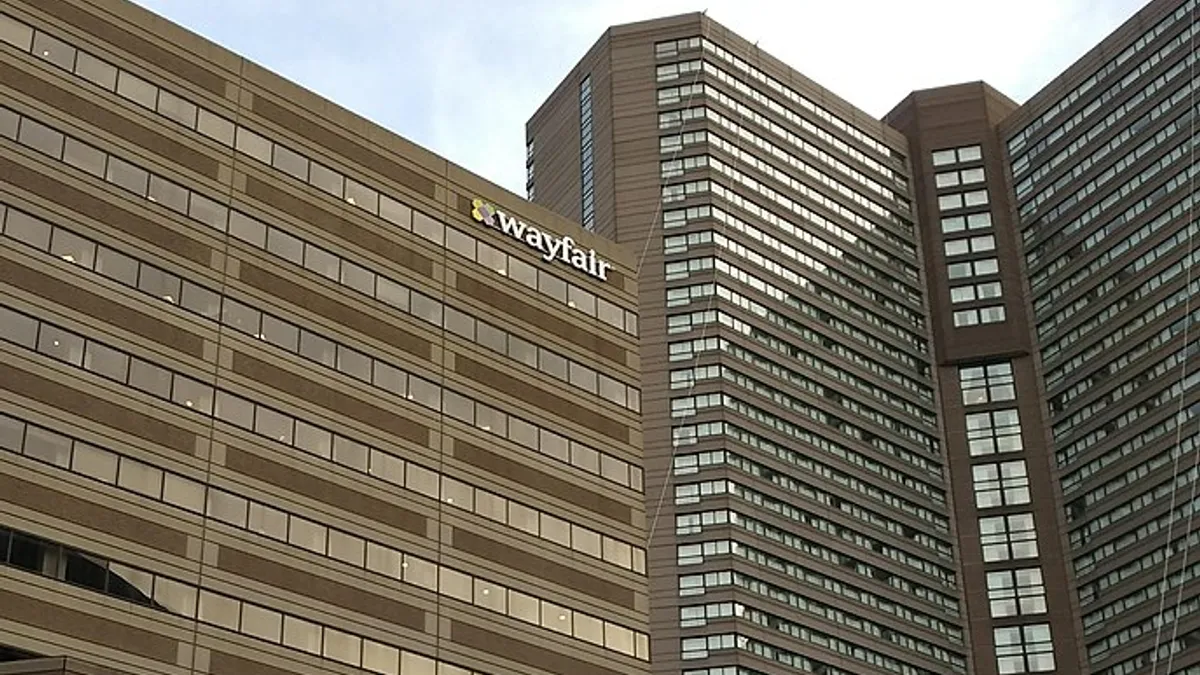Dive Brief:
-
Wayfair confirmed to Retail Dive it has laid off about 550 employees. The company said it employs more than 17,000 workers globally.
-
Of the 550 employees impacted, 350 are based in Boston, where the e-commerce retailer is headquartered, the company confirmed.
-
"[W]e continually evaluate the needs of the business and work to increase efficiencies while aligning our teams with the initiatives that drive the greatest impact for our customers," a company statement emailed to Retail Dive said. "As part of that process, we have made some organizational changes that affect approximately three percent of our global workforce. We are continuing to hire for the many roles needed to drive our long-term success and the continued growth of the business."
Dive Insight:
The staff cuts at Wayfair come shortly after layoffs at Birchbox and Walmart-owned Bonobos, and are the second from an e-commerce home brand in as many months.
In January, Walmart announced layoffs at its Allswell direct-to-consumer brand, which impacted 29 employees (more than half the workforce from its New York office). A Walmart spokesperson, however, noted that "the Allswell brand and its team members will get integrated into the Walmart business."
Though the online home goods market grew 88.7% between 2013 and 2018, according to Euromonitor, the financial viability around digital-first models remains questionable.
Wayfair has taken up more share of the home goods segment, negatively impacting traditional players like Pier 1, and has grown its active customer base to 19.1 million users as of last October. According to 1010data, Wayfair generated a third (33.4%) of online furniture sales in 2019, followed closely by Amazon (29.7%). Far behind are more traditional players like Walmart (4.7% of online furniture sales) and Macy's (3.7%).
"While almost all of the leading merchants posted steady sales gains in 2019, Wayfair is driving category growth," 1010data Senior Director Matt Pace said in emailed comments to Retail Dive.
However, since its public debut in 2014, the e-commerce player has failed to post a profit. In its past quarter, Wayfair's net loss widened 80% to $272 million, while its long-term debt swelled to $1.4 billion, from $347 million the year prior.

Wayfair has also been doubling down on its advertising spend in recent years. In the first nine months of its current fiscal year, the company spent nearly $785 million on advertising expenses. Comparatively, advertising for its entire fiscal year in 2018 was $774 million.
As the cost of customer acquisition becomes prohibitively high for online retailers, many are forced to enter brick and mortar. Wayfair last August opened its first permanent location at the Natick Mall in Natick, Massachusetts, after testing temporary pop-up locations in various markets.
Trade tensions are also likely pressuring the online retailer. Though the U.S. canceled list 4B tariffs last December, tariffs remain in place on about $370 billion worth of imports from China. Chief Financial Officer Michael Fleisher said on a call with analysts last quarter that since the beginning of 2019, "more than 90% of our suppliers who are subject to China tariffs have raised wholesale prices, which have resulted in higher retail prices," adding that changes in prices are causing shoppers to purchase with more caution.
"Toward the end of 2019 management was increasingly vocal on the opportunity to leverage labor costs across most all facets of the business," William Blair analyst Dylan Carden said in a client note emailed to Retail Dive. "These layoffs, however, suggest that the company is seeing further revenue deceleration beyond its initial targets that informed hiring over the last two years, with likely lingering impact from tariffs, which only started to show up in the model in the third quarter, bringing near-term margin expectations to their lowest level since at least 2012."














